Special notice: Sound Alchemy–Bio-Acoustic trainings are now online! Join the global practitioners in the magic of sound medicine.
by Ani Williams, July 2000
The sky and its stars make music in you.
— Dendera wall inscription
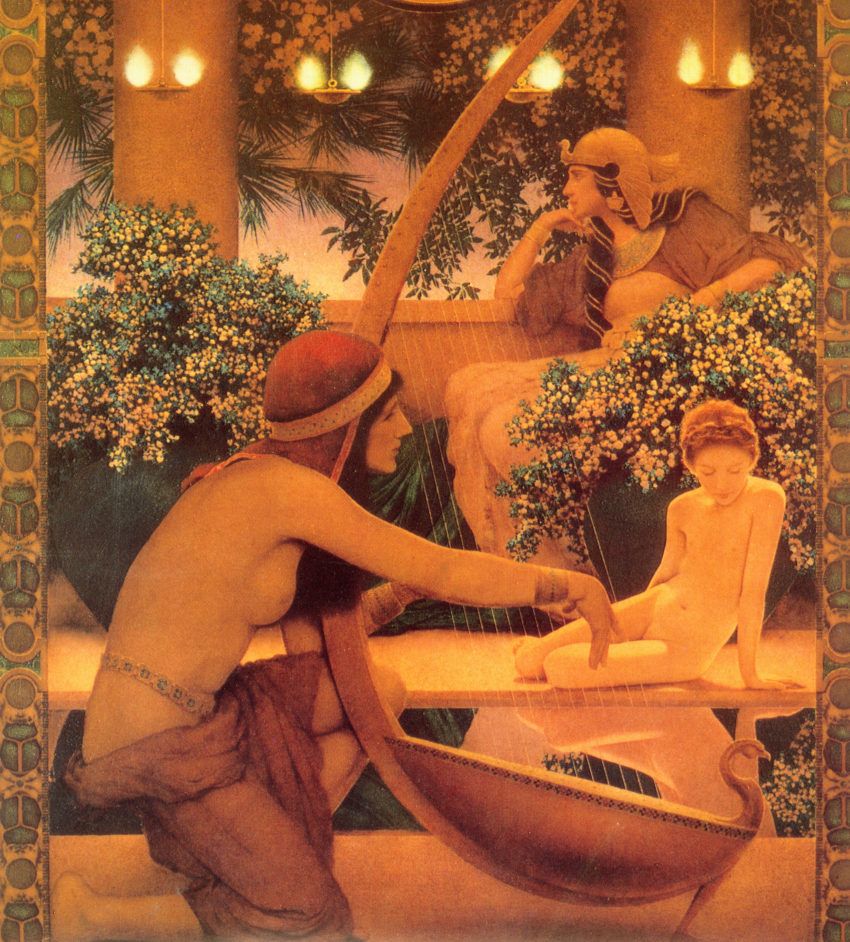
Frankincense and myrrh wafted through the great pillars in the temple at Dendera Egypt. Harp strings sounded the ancient chords as voices chanted in the processional toward the Holy of Holies. I could sense the timelessness of our ritual entrance to the temple of Hathor, Goddess of music, dance and beauty. Hathor, or Heb-Hor, meaning “House of Horus” is the Great Mother of birth, life, death, and the harmonious state of well-being that is sustained by the power and beauty (Nefer) of song. Her connection to sacred music can be seen carved on the temple pillars with harps, double pipes, sistrum (rattles), tambourines, and sacred dancers offering gifts for the abundant life of creation. Hathor is the Lady of the Gates of transitions in which music and sacred sound open the pathway through the dimensions.

Passing beneath the large figurative zodiac painted on the ceiling, I was reminded of a statement I heard years ago, that human life will never reach its full potential until our lives become a mirror of nature. Most cultures previous to the current industrial and technologically based societies, took into account not only the terrestrial but also the celestial cycles in designing their temples and regulating their ritual cycles.
Temples Mirror Star Patterns
“Whosoever shall make a copy thereof (of the cosmos), and shall know it upon the earth, it shall act as a magical protector for him both in heaven and upon earth.” — Heaven’s Mirror by Graham Hancock
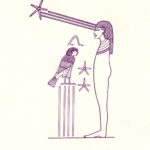
In ancient Egypt, music, architecture and astronomy were combined in a concise, harmonious unified system, where heaven and earth were not isolated realms and science and religion were an integrated, mutually supportive system. From the research of Andrew Collins (The Cygnus Key), Robert Bauval (The Orion Mystery) and Graham Hancock (Fingerprints of the Gods), and from the book The Message of the Sphinx, which Hancock and Bauval co-authored, we find many examples of Egyptian temple designs reflecting cosmic and earthly cycles.

The Great Pyramid is aligned to true north-south (as opposed to magnetic N-S), which is based on the actual points around which the earth’s axis spins. According to several researchers, the three Egyptian pyramids of the Giza Plateau mirror the offset line up of the three stars in the belt of Orion, with the Nile to the West mirroring the Milky Way’s river of stars to the west of Orion. However, Andrew Collins’ research has found that the Giza pyramids are mirroring the Swan constellation Cygnus, also equated with Nut the sky goddess and the Milky Way.
The shafts inside the Queens and Kings chambers were aimed directly at the bright stars important in Egyptian cosmology, such as Sirius, Orion and Thuban in the constellation Draco, which was the polestar circa 2800 BCE. And a short distance away, the Sphinx faces east, gazing at the point on the horizon where the constellation of Leo would have risen about 13,000 years ago. Most likely, the dating of the Sphinx is much older than its dating by most archeologists.
If you are wondering how the constellation of Leo could have been rising in spring, here is an explanation:
In our current time, the constellation rising in the east at the Vernal Equinox, is Aries. The entry of the sign of Aries signals the beginning of spring. But due to the precession of the equinoxes, 13,000 years ago the constellation rising would have been Leo. And what is this precession of the equinoxes?
In 129 B.C.E, the Greek astronomer Hipparchus completed his renowned star catalog, in which he explains this phenomenon. He noticed that the positions of the stars moved in a systematic way and that although the stars weren’t moving, our observation from Earth was shifting. Due to the slight wobble of the Earth’s axis as it rotates, the observed location of stars at their rising point on the horizon slowly drifts.
Every 72 years the precession or movement of the observed star positions, drifts one degree. 72 is a number found in the dimensions of pyramids of Mexico, Cambodia and Egypt and is an angle of the pentagram, which gives a perfect example of PHI Golden Mean ratio. A thirty-degree drift occurs every 2160 years, when we move into the next age, or zodiac sign. Every 12,960 years, the scene moves one hundred and eighty degrees, and every 25,920 years, a complete cycling of three hundred and sixty degrees of movement, passing through all twelve ages and zodiacal signs.
According to Mayan, Tibetan and other ancient timekeepers, we are now completing a great cycle of 26,000 years, and beginning a new era. Every changing epoch, especially our current great cycle shift, requires rethinking our reality and sound as a creative force comes forward now as a primary tool for change and healing.
Temple Acoustics
“By the irresistible force, rightly directed, of the harmonics of sound–he can flatten the menace of Jericho’s impregnable walls, or raise serenely, like Amphion with the sound of his Lyre, the walls of Thebes whose stones came and placed themselves in rhythm and in meter…” — The Mystery Of The Seven Vowels by Joscelyn Godwin, author and Professor of Music at Colgate University
Egypt’s architects were sophisticated astronomers and ‘sky watchers’. They built their structures to be powerful harmonic resonators–according to the dimensions and design of the temple chambers, potent acoustical effects could be created with the use of certain sounds and musical frequencies.
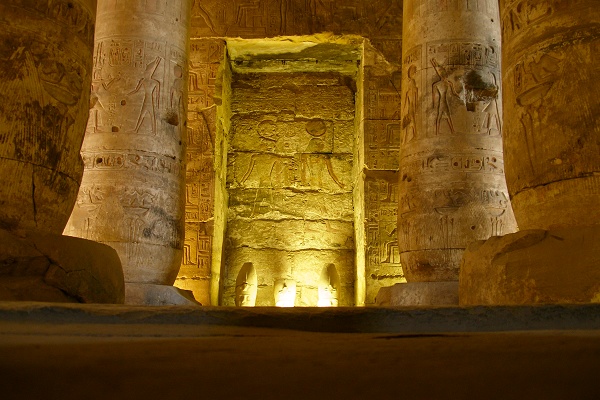 During my first visit to Abydos, Egypt in 1987, I was struck by the “aliveness” of the temple stones as we were chanting. Our group observed the stones echoing and singing back to us in waves of symbiotic sound. Dr. James Hurtak, author and scholar of ancient Hebrew texts, calls the Egyptian pyramids voice-activated geophysical computers. Dr. Hurtak is said to have produced visible standing waves of light within and above the pyramids, when intoning specific tones and Hebrew sacred words. Some of the effects of hearing or producing natural harmonic sounds are increased sensory perception as well as an expanded state of awareness. This is a common effect after singing or chanting. Thus during temple rituals, those attending could enter altered states of consciousess)
During my first visit to Abydos, Egypt in 1987, I was struck by the “aliveness” of the temple stones as we were chanting. Our group observed the stones echoing and singing back to us in waves of symbiotic sound. Dr. James Hurtak, author and scholar of ancient Hebrew texts, calls the Egyptian pyramids voice-activated geophysical computers. Dr. Hurtak is said to have produced visible standing waves of light within and above the pyramids, when intoning specific tones and Hebrew sacred words. Some of the effects of hearing or producing natural harmonic sounds are increased sensory perception as well as an expanded state of awareness. This is a common effect after singing or chanting. Thus during temple rituals, those attending could enter altered states of consciousess)

“Careful scientific examination of the world’s key pyramid sites, reveal them to be sophisticated harmonic structures, not only mirroring positions of the planets and stellar systems, but designed to mimic the chakras and harmonic cavities of the human body.” — Paul White, temple harmonic researcher.
This mysterious mirroring effect between earth and sky in ancient temples also occurs in human energy fields. In 1992, I pursued a deeper study of sound medicine and found startling correlations between human physical and emotional health and the patterns of sound frequencies of the voice. The vocal patterns (found through Voice Spectrum Analysis) also are found to mirror the individual’s planetary and star patterns at the time of birth. The NASA recordings of the sounds of the planets demonstrate the unique “songs” of our solar system. Are these celestial songs singing us? After analyzing the sound patterns in thousands of people in England, Mexico and in the US, we have discovered a profound link that the ancient Egyptians were alluding to when they inscribed the following on the Dendera temple wall: The sky and its stars make music in you.
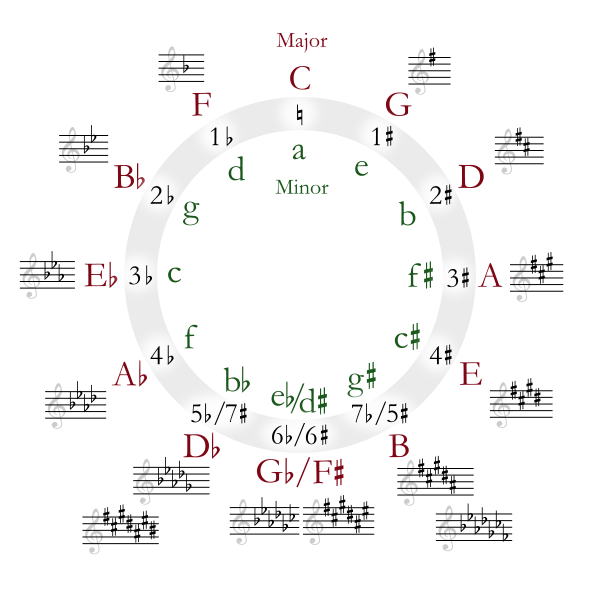
 The divine order of the movements of the cosmos and the sacred proportions found in ancient temple design, are the same principles found in music. The development of the western musical scale is normally attributed to the Greek Pythagoras, who was known to have studied in Egypt. Pythagoras taught that the music scales were based on planetary tones and students were instructed in the use of specific modes for healing. The western musical scale is based on the interval of the fifth (five white keys on a piano). By beginning with Do, or ‘C’ and continuing in a progression from fifth to fifth, we complete the circle of fifths and our entire twelve tone chromatic scale. (See Circle of Fifths chart to right)
The divine order of the movements of the cosmos and the sacred proportions found in ancient temple design, are the same principles found in music. The development of the western musical scale is normally attributed to the Greek Pythagoras, who was known to have studied in Egypt. Pythagoras taught that the music scales were based on planetary tones and students were instructed in the use of specific modes for healing. The western musical scale is based on the interval of the fifth (five white keys on a piano). By beginning with Do, or ‘C’ and continuing in a progression from fifth to fifth, we complete the circle of fifths and our entire twelve tone chromatic scale. (See Circle of Fifths chart to right)
“… the Egyptians utilized musical scales analogous to our own. The positions of the harpists’ hands on the strings clearly indicate ratios such as the fourth, fifth and octave, revealing an unquestionable knowledge of the laws governing musical harmony.“ — Lucy Lamy, Egyptian Mysteries (Thames and Hudson 1981)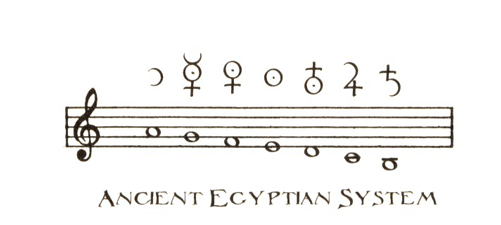
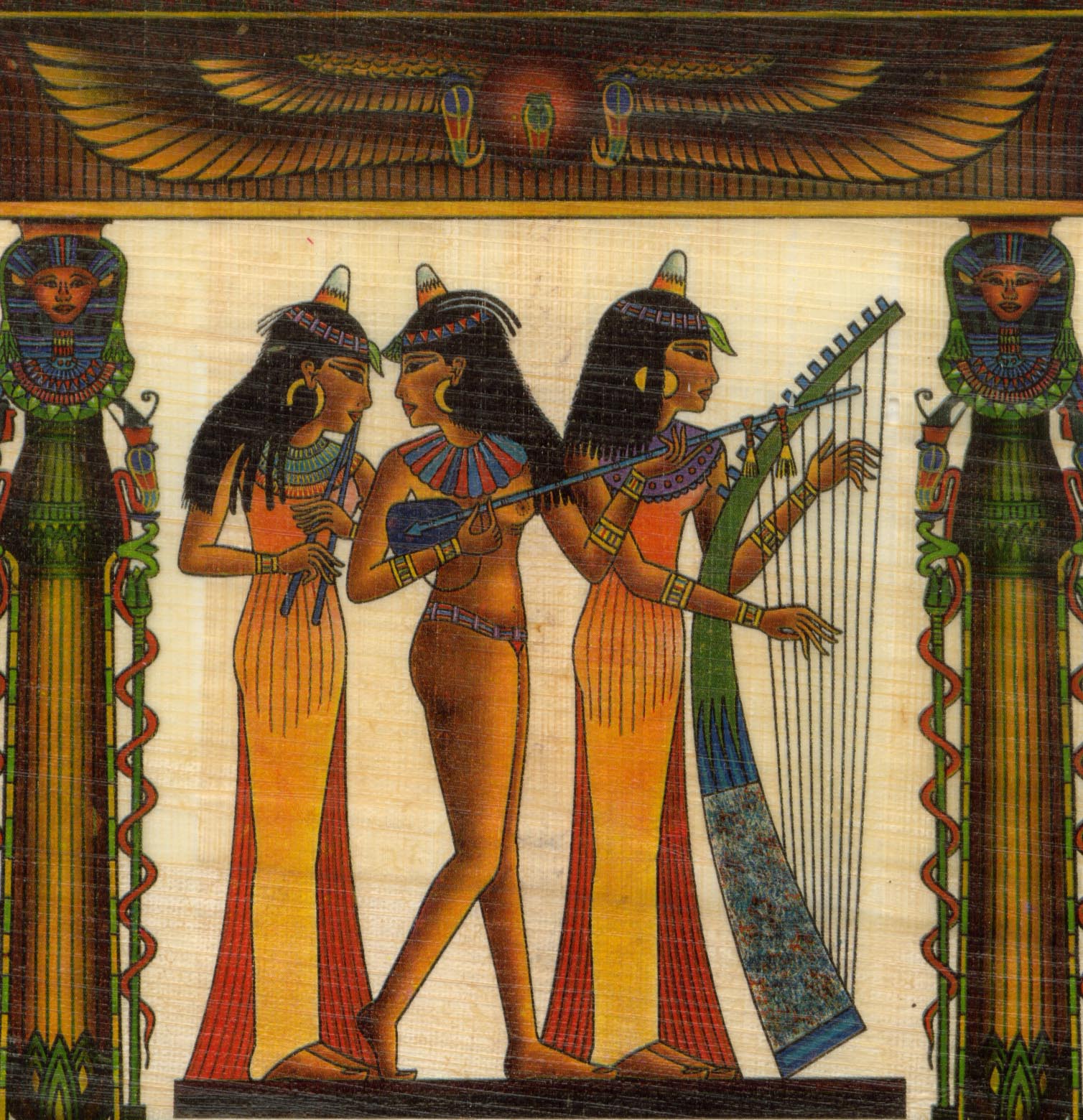 In the book The Power of Limits, architect Gyorgy Doczi surveys the similarity between the basis of temple proportions, the Golden Mean ratio (.618) and the interval of the fifth in music (.667). (Actually, the closest musical interval to Phi, Golden Mean ratio is a minor sixth) The fifth is the interval found in most sacred music and has a powerful harmonizing effect on the human energy system. All of creation expresses itself through number (as in the Neters of Egypt, which represent the laws of creating through sound), and number is frequency, ratio, harmonics of both form and energy.
In the book The Power of Limits, architect Gyorgy Doczi surveys the similarity between the basis of temple proportions, the Golden Mean ratio (.618) and the interval of the fifth in music (.667). (Actually, the closest musical interval to Phi, Golden Mean ratio is a minor sixth) The fifth is the interval found in most sacred music and has a powerful harmonizing effect on the human energy system. All of creation expresses itself through number (as in the Neters of Egypt, which represent the laws of creating through sound), and number is frequency, ratio, harmonics of both form and energy.
Goethe, the German mystic and poet stated that architecture or geometry is frozen music. With hopes of discovering an underlying harmonious system in Egyptian temple design and acoustical properties, in 1991, colleague Antoine Seronde and I conducted research in numerous chambers in the temples at Edfu, Abydos, Philae and Dendera. By striking a series of notes on the harp and chanting individual tones in each chamber, certain tones were heard to ring out with a fuller resonance. By comparing these observed dominant tones with the expected dominant tones calculated from the dimensions of the chambers, approximately 80% corresponded. Could these dominant tones have been intentionally created to bring about intended effects in those present?
“The most common proportions found in ancient Egyptian temple architecture correspond to the most harmonious intervals found in music: the octaves, fifths, fourths, thirds and sixths. In the temple of Horus at Edfu, the dimensions of one chamber’s measurements of width to height equaled 2:3, which defines an interval of a fifth in music. And the ratio of the height to the length equaled 3:4, which defines an interval of a fourth. We found similar correspondences between architectural ratios and musical intervals in most of the other rooms we investigated.” — “Rediscovering Music in the Architecture of Ancient Egyptian Temples” (unpublished article) by Antoine Seronde.
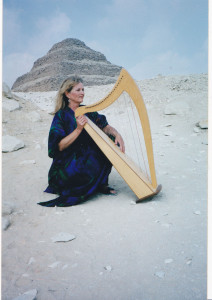
In the complex at Abydos, Antoine Seronde, myself and a team of observers explored the effects of the acoustic response in the various temple chambers. We experienced a profound altered state of consciousness with the changing acoustic response as we moved through the temple. The rear section of the Abydos temple plan is said to correspond to the body of Osiris.
As I chanted and played the harp beginning in the chambers relating to the lower chakras of the body, the harmonics were deeper in tone. As I moved to the center of the body the sound became very full and expansive. When I arrived at the small chamber related to the crown chakra at the opposite end of the temple, the resonance became so exquisitely high and refined, that it created a feeling of ecstasy and transcendence.
Our temple acoustic research revealed proposed musical scales which we based on two methods. First, Antoine and his team calculated the mathematical measurements of each chamber and arrived at a number translated into frequency Hertz, or sound wave cycles per second. Secondly, our team observed the dominant acoustic response in these same chambers. The observed dominant tones in each chamber mirrored the frequencies proposed by the mathematical measurements of each chamber.
During the years since this research, I have continued to use our proposed temple scales with numerous groups and audiences. The music played with these intervals has served as a bridge to bring the listeners into a virtual sound journey to the ancient Egyptian culture. You can hear samples of this Egyptian musical scale here: https://aniwilliams.com/product/homage-to-hathor-mp3/
Is this what the ancients had in mind when they constructed these magnificent temples? Adrian Gilbert, author of the book ‘Signs in the Sky’ has stated that he has found evidence that the Egyptian pyramids of Giza were laid out to mark our present epoch, which began at about 10,880 BC. Isn’t it time to utilize the codes embedded in musical harmony and sacred geometry for healing humanity and our beloved Earth?
Sound Alchemy–Bio-Acoustic trainings are now online! Join the global practitioners in the magic of sound medicine.
Related music with Egyptian Temple Scales: https://aniwilliams.com/product/song-of-isis-mp3/ https://aniwilliams.com/product/homage-to-hathor-mp3/
Text and photos ©Ani Williams July 2000


